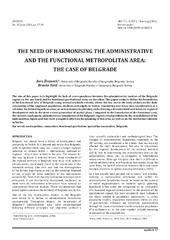The need of harmonising the administrative and the functional metropolitan area: The case of Belgrade
Апстракт
The aim of this paper is to highlight the lack of correspondence between the administrative borders of the Belgrade region on the one hand, and its functional gravitational area, on the other. The paper seeks to define the boundaries of the functional area of Belgrade using several available criteria, where the key one is the body of data on the daily commuting of the employed population, students and pupils. In Serbia, commuting was taken into consideration as a criterion for delimiting urban areas, or an instrument in planning and achieving a decentralised and balanced regional development only in the most recent generation of spatial plans. Compared to the boundaries of the functional area, the current, inadequate, administrative boundaries of the Belgrade region reveal problems in the consolidation of the metropolitan region and they have a negative effect on the planning of this area, as well as on the territorial cohesion in Serbia.
Кључне речи:
Belgrade / Commuters / Functional gravitation / Metropolitan / Spatial harmonisationИзвор:
Spatium, 2016, 1, 35, 37-44Издавач:
- Beograd : Institut za arhitekturu i urbanizam Srbije
Колекције
Институција/група
Geografski fakultetTY - JOUR AU - Živanović, Zora AU - Tošić, Branka PY - 2016 UR - https://gery.gef.bg.ac.rs/handle/123456789/744 AB - The aim of this paper is to highlight the lack of correspondence between the administrative borders of the Belgrade region on the one hand, and its functional gravitational area, on the other. The paper seeks to define the boundaries of the functional area of Belgrade using several available criteria, where the key one is the body of data on the daily commuting of the employed population, students and pupils. In Serbia, commuting was taken into consideration as a criterion for delimiting urban areas, or an instrument in planning and achieving a decentralised and balanced regional development only in the most recent generation of spatial plans. Compared to the boundaries of the functional area, the current, inadequate, administrative boundaries of the Belgrade region reveal problems in the consolidation of the metropolitan region and they have a negative effect on the planning of this area, as well as on the territorial cohesion in Serbia. PB - Beograd : Institut za arhitekturu i urbanizam Srbije T2 - Spatium T1 - The need of harmonising the administrative and the functional metropolitan area: The case of Belgrade VL - 1 IS - 35 SP - 37 EP - 44 DO - 10.2298/SPAT1635037Z UR - https://hdl.handle.net/21.15107/rcub_gery_744 ER -
@article{
author = "Živanović, Zora and Tošić, Branka",
year = "2016",
abstract = "The aim of this paper is to highlight the lack of correspondence between the administrative borders of the Belgrade region on the one hand, and its functional gravitational area, on the other. The paper seeks to define the boundaries of the functional area of Belgrade using several available criteria, where the key one is the body of data on the daily commuting of the employed population, students and pupils. In Serbia, commuting was taken into consideration as a criterion for delimiting urban areas, or an instrument in planning and achieving a decentralised and balanced regional development only in the most recent generation of spatial plans. Compared to the boundaries of the functional area, the current, inadequate, administrative boundaries of the Belgrade region reveal problems in the consolidation of the metropolitan region and they have a negative effect on the planning of this area, as well as on the territorial cohesion in Serbia.",
publisher = "Beograd : Institut za arhitekturu i urbanizam Srbije",
journal = "Spatium",
title = "The need of harmonising the administrative and the functional metropolitan area: The case of Belgrade",
volume = "1",
number = "35",
pages = "37-44",
doi = "10.2298/SPAT1635037Z",
url = "https://hdl.handle.net/21.15107/rcub_gery_744"
}
Živanović, Z.,& Tošić, B.. (2016). The need of harmonising the administrative and the functional metropolitan area: The case of Belgrade. in Spatium Beograd : Institut za arhitekturu i urbanizam Srbije., 1(35), 37-44. https://doi.org/10.2298/SPAT1635037Z https://hdl.handle.net/21.15107/rcub_gery_744
Živanović Z, Tošić B. The need of harmonising the administrative and the functional metropolitan area: The case of Belgrade. in Spatium. 2016;1(35):37-44. doi:10.2298/SPAT1635037Z https://hdl.handle.net/21.15107/rcub_gery_744 .
Živanović, Zora, Tošić, Branka, "The need of harmonising the administrative and the functional metropolitan area: The case of Belgrade" in Spatium, 1, no. 35 (2016):37-44, https://doi.org/10.2298/SPAT1635037Z ., https://hdl.handle.net/21.15107/rcub_gery_744 .




